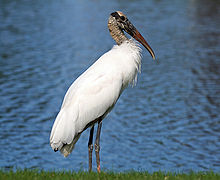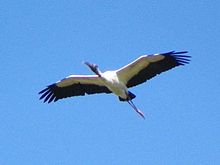- Wood Stork
-
Wood Stork Pond, Tampa Bay, FL
 Chick vocalizations (help·info)
Chick vocalizations (help·info)Conservation status Scientific classification Kingdom: Animalia Phylum: Chordata Class: Aves Order: Ciconiiformes Family: Ciconiidae Genus: Mycteria Species: M. americana Binomial name Mycteria americana
Linnaeus, 1758The Wood Stork (Mycteria americana) is a large American wading bird in the stork family Ciconiidae. It was formerly called the "Wood Ibis", though it is not really an ibis.
Contents
Appearance
The adult is a large bird 83–115 cm (33–45 in) tall and 140–180 cm (58–71 in) in wingspan. Males typically weigh 2.5–3.3 kg (5.5-7.3 lbs); females weigh 2.0–2.8 kg (4.4-6.2 lbs),[2] although large birds are up to 4.5 kg (10 lbs).[3] It appears all white on the ground, with blackish-gray legs and pink feet. In flight, the trailing edge of the wings is black. The head is dark brown with a bald, black face, and the thick downcurved bill is dusky yellow. Juvenile birds are a duller version of the adult, generally browner on the neck, and with a paler bill.
Habitat and breeding
This is a subtropical and tropical species which breeds in much of South America, Central America and the Caribbean. The Wood Stork is the only stork that presently breeds in North America. In the United States there is a small and endangered breeding population in Florida, Georgia, and South Carolina, along with a recently discovered rookery in southeastern North Carolina. On the other hand, in Santa Catarina state (Brazil), its decline seems to have been reversed: after an absence between the late 1960s and the mid-1990s, the species is now again regularly encountered there, in particular in the Tubarão River region.[4] It is likely that the Paraná River region's wetlands served as a stronghold of the species, from where it is now re-colonizing some of its former haunts.[5] Globally, it is considered a Species of Least Concern by the IUCN due to its large range.[6]
The Wood Stork is a broad-winged soaring bird that flies with its neck outstretched and legs extended. It forages usually where lowering water levels concentrate fish in open wetlands; it also frequents paddy fields. Walking slowly and steadily in shallow water up to its belly, it seeks prey, which, like that of most of its relatives, consists of fish, frogs and large insects. It catches fish by holding its bill open in the water until a fish is detected.[7]
In the United States. the Wood Stork favors cypress trees in marshes, swamps, or (less often) among mangroves and nearby habitat.[8] The Wood Stork's endangered status resulted in the salvation of the small rural town of Colquitt, Georgia. When the Department of Transportation was planning the construction of Highway 27, they intended to bypass the small community. The plans included a new bridge over Spring Creek and the swampy areas surrounding Colquitt. However, the residence of the Wood Stork in the swampy woodlands of Southwest Georgia required that the DOT use the existing bridge in Colquitt. Had the new bridge been built and the town bypassed, the town's economy would be little of what it is today. Colquitt is the home of Georgia's Folk Life Play, Swamp Gravy, a theatrical production which brings in audience members from across the country. The old movie theater on the town square is currently being renovated to be a conference and concert hall, named The Woodstork Center.
A resident breeder in lowland wetlands with trees, the Wood Stork builds a large stick nest in a forest tree. They nest colonially with up to twenty-five nests in one tree.[8] Breeding once a year, a female lays 3-5 eggs in the typical clutch. The eggs are incubated 27–32 days by both sexes. Wood Storks' reproductive cycle is triggered when waterholes dry up sufficiently to concentrate fish in sufficient numbers for efficient feeding of the chicks. Each chick weighs approximately 2 ounces (60 grams), is unable to fly and is helpless. Competition for food is fierce, and if food is scarce, only the older chicks will survive. Week-old chicks are fed about 15 times per day, and they grow rapidly. By 14 days, each will weigh 10 times its hatching weight. At 28 days, each is 25 times heavier. During the breeding season, Wood Storks need over 400 pounds (180 kg) of fish to feed themselves and their offspring. When the weather is very warm, parents also collect water and bring it to the nest to drool on and into the mouths of the chicks. By the time the young are 4 weeks old, both parents leave the nest to search for food, and this continues until the chicks “fledge” or leave the nest. Young may continue to return to the colony for another 10 to 15 days to roost or to try to get food from their parents. A colony is considered successful if its parents average at least 1.5 fledged young per nest.[9]
Each adult will defend its nest against various predators. Corvids, vultures, grackles and striped skunks will attempt to pick off eggs.[9] Raccoons are the leading predator of nests, and can cause almost complete colony nesting failure when water dries under nests in drought years.[10] Adults are rarely preyed on, but unwary ones have been picked off by American alligators.[11]
Evolution
This species seems to have evolved in tropical regions; its North American presence probably postdates the last ice age. A fossil fragment from the Touro Passo Formation found at Arroio Touro Passo (Rio Grande do Sul, Brazil) might be of the living species; it is at most from the Late Pleistocene age, a few 10,000s of years ago.[12] North American fossils from that time are of an extinct larger relative, M. wetmorei. This was probably a sister species; both occurred sympatrically on Cuba at the end of the Pleistocene.[13]
References
Footnotes
- ^ BirdLife International (2008). Mycteria americana. In: IUCN 2008. IUCN Red List of Threatened Species. Downloaded on 30 July 2009.
- ^ http://www.sciencedirect.com/science?_ob=ArticleURL&_udi=B6VB5-452WBM7-1&_user=1533172&_rdoc=1&_fmt=&_orig=search&_sort=d&view=c&_acct=C000053602&_version=1&_urlVersion=0&_userid=1533172&md5=ad23f89a784591959de98e8355cf3e21
- ^ http://pelotes.jea.com/wodstrk.htm
- ^ Amorim & Piacentini (2006)
- ^ Bencke (2007)
- ^ BLI (2008)
- ^ Sibley (2003): p.58
- ^ a b Ehrlich, Dobkin & Wheye (1992)
- ^ a b http://www.jaxzoo.org/animals/biofacts/WoodStork.asp
- ^ http://bna.birds.cornell.edu/bna/species/409/articles/behavior
- ^ http://animaldiversity.ummz.umich.edu/site/accounts/information/Mycteria_americana.html
- ^ Schmaltz Hsou (2007)
- ^ Suárez & Olson (2003)
Literature
- Amorim, James Faraco & Piacentini, Vítor de Queiroz (2006): Novos registros de aves raras em Santa Catarina, Sul do Brasil, incluindo os primeiros registros documentados de algumas espécies para o Estado [New records of rare birds, and fi rst reports of some species, in the state of Santa Catarina, southern Brazil]. Revista Brasileira de Ornitologia 14(2): 145-149 [Portuguese with English abstract]. PDF fulltext Electronic supplement
- Bencke, Glayson Ariel (2007): Avifauna atual do Rio Grande do Sul, Brasil: aspectos biogeográficos e distribucionais ["The Recent avifauna of Rio Grande do Sul: Biogeographical and distributional aspects"]. Talk held on 2007-JUN-22 at Quaternário do RS: integrando conhecimento, Canoas, Rio Grande do Sul, Brazil. PDF abstract in Portuguese
- Ehrlich, Paul R.; Dobkin, David S.; Wheye, Darryl (1992). Birds in Jeopardy. Stanford, CA: Stanford University Press. pp. 18. ISBN 0-8047-1967-5.
- BirdLife International (BLI) (2008). Mycteria americana. In: IUCN 2008. IUCN Red List of Threatened Species. Downloaded on 2 February 2009. Database entry includes justification for why this species is of least concern
- Schmaltz Hsou, Annie (2007): O estado atual do registro fóssil de répteis e aves no Pleistoceno do Estado do Rio Grande do Sul, Brasil ["The current state of the fossil record of Pleistocene reptiles and birds of Rio Grande do Sul"]. Talk held on 2007-JUN-20 at Quaternário do RS: integrando conhecimento, Canoas, Rio Grande do Sul, Brazil. PDF abstract in Portuguese
- Sibley, David Allen (2003): The Sibley Field Guide to Birds of Eastern North America. Alfred A. Knopf, New York. ISBN 0-679-45120-X
- Suarez, William & Olson, Storrs L. (2003): New Records of Storks (Ciconiidae) from Quaternary Asphalt Deposits in Cuba. Condor 105(1): 150-154. DOI:10.1650/0010-5422(2003)105[150:NROSCF]2.0.CO;2 PDF fulltext
Further reading
- Alsop, Fred J. III (2002): Birds of Texas. DK Publishing, Inc., New York City. ISBN 0789483882
External links
- Wood Stork Species Account - Cornell Lab of Ornithology
- Wood Stork - Mycteria americana - USGS Patuxent Bird Identification InfoCenter
- Wood Stork Information - South Dakota Birds and Birding
- Wood Stork Bird Sound
Storks (order: Ciconiiformes • family: Ciconiidae) Genus Mycteria Milky Stork (M. cinerea) • Yellow-billed Stork (M. ibis) • Painted Stork (M. leucocephala) • Wood Stork (M. americana)Anastomus Ciconia Abdim's Stork (C. abdimii) • Woolly-necked Stork (C. episcopus) • Storm's Stork (C. stormi) • Maguari Stork (C. maguari) • Oriental Stork (C. boyciana) • White Stork (C. ciconia) • Black Stork (C. nigra)Ephippiorhynchus Jabiru Leptoptilos 19 living species in six genera Categories:- IUCN Red List least concern species
- Mycteria
- Storks
- Birds of the Caribbean
- Birds of Central America
- Birds of Mexico
- Birds of South America
- Native birds of the Southeastern United States
- Birds of the United States
- Animals described in 1758
Wikimedia Foundation. 2010.





